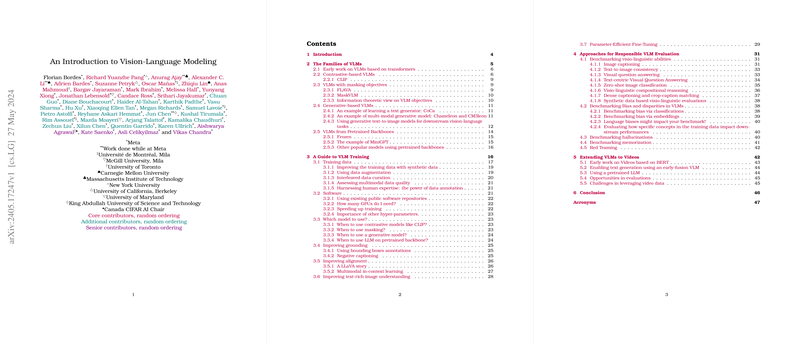Vision-LLMs (VLMs): A Comprehensive Overview
The extension of LLMs to the visual domain has yielded Vision-LLMs (VLMs) that promise to revolutionize our interaction with technology. From aiding navigation in unfamiliar environments to generating images from textual descriptions, VLMs offer a plethora of applications. However, significant challenges remain regarding their reliability and performance. This paper provides an in-depth introduction to VLMs, including their training paradigms, evaluation methods, extensions to videos, and future research directions.
Families of VLMs
The diverse approaches to training VLMs can be categorized into four primary paradigms:
- Contrastive Training: This method leverages pairs of positive and negative examples. By predicting similar representations for positive pairs and different representations for negative pairs, contrastive training ensures that VLMs effectively align visual and textual data. Key models in this paradigm include CLIP and its variants like SigLIP and Llip.
- Masking Objectives: Masking strategies have been pivotal in NLP (e.g., BERT) and have been extended to VLMs. By reconstructing masked image patches or text tokens, models like FLAVA and MaskVLM demonstrate the efficacy of masking in the vision-language interface.
- Generative Models: Generative models aim to produce images or text based on input modalities. These models, such as CoCa, CM3leon, and Parti, often incorporate complex architectures and significant computational resources to generate high-quality outputs.
- Pre-trained Backbones: Leveraging pre-trained LLMs or visual encoders, models like Frozen and MiniGPT reduce the computational burden by focusing on mapping textual and visual representations. This approach capitalizes on existing models like LLaMA or GPT to integrate multi-modal data effectively.
Training Considerations
Training VLMs demands significant computational resources and well-curated datasets. Several strategies can optimize training:
- Data Curation: High-quality, diverse datasets are crucial. Techniques such as data pruning, bootstrapping with pre-trained VLMs, and synthetic data generation enhance training efficacy. Data augmentation and balancing ensure robust model performance across various downstream tasks.
- Compute Resources: Efficient use of GPUs, data loading optimizations, and computational techniques like masking can accelerate training while maintaining model performance.
- Selecting the Right Model: The choice of training paradigm depends on specific use cases and resource availability. Contrastive models excel in association tasks, masking models in discrete representation learning, generative models in detailed data generation, and pre-trained backbones in low-resource settings.
Enhancing Model Performance
Improving grounding and alignment is essential for model reliability:
- Grounding: Techniques like bounding box annotations and negative captioning enhance a model's ability to map textual descriptions to specific visual elements accurately.
- Alignment: Instruction tuning and reinforcement learning from human feedback (RLHF) ensure that VLMs generate outputs aligned with human expectations and reduce hallucination tendencies.
Evaluation Methods
Evaluating VLMs involves several benchmarks to assess their text-image alignment and generalization capabilities:
- Visio-Linguistic Abilities: Image captioning, visual question answering (VQA), and zero-shot classification tasks evaluate a model's ability to interpret and generate accurate descriptions.
- Reasoning: Benchmarks like Winoground and ARO test a model's compositional reasoning, ensuring it can distinguish between correct and incorrect descriptions based on spatial and relational understanding.
- Bias and Memorization: Evaluating biases in classification and embedding spaces, along with testing memorization tendencies, ensures the ethical deployment of VLMs.
Extending VLMs to Videos
Extending VLMs to videos introduces new challenges and opportunities. Video data requires models to understand motion dynamics and temporal relationships, offering richer context for tasks like video question answering and action recognition. Models like VideoBERT and Video-LLaMA exemplify successful video-language integration, capable of generating detailed descriptions and answering complex queries about dynamic scenes.
Conclusion
The development of VLMs is a rapidly evolving field with significant potential. As researchers continue to address challenges in data curation, computational efficiency, grounding, and alignment, VLMs promise to become increasingly robust and versatile. The integration of video data further broadens the scope of applications, driving advancements in AI's ability to understand and interact with our visual world.
